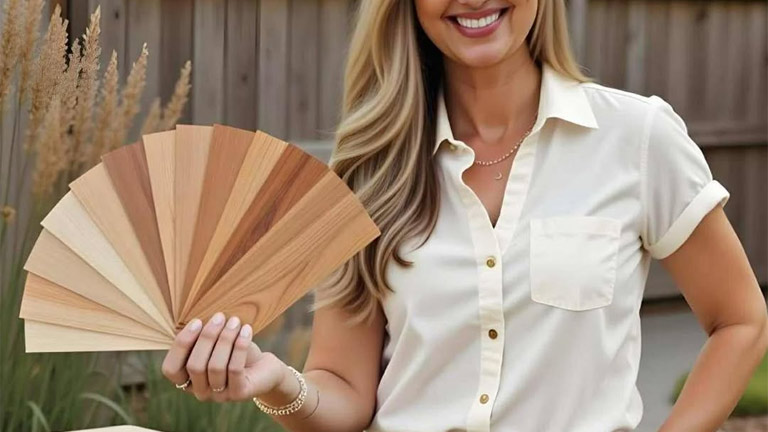
Wood material in your home can make a room look and feel much bigger or smaller, look warmer or colder, and even reveal a bit of your personality in the design.
You may be the one who prefers the lightness of maple or the richness of mahogany, and wood shades color is a way of creating ambience that paint or fabric alone cannot achieve. This renders them to be among the most crucial design features in both modern and traditional households.
This article will take you through the significance of wood tones, how they affect atmosphere, and how to match them with other elements of design. At the end, you will understand better how to choose wood shade colors that not only fit your house design but also your style.
Wood Shades
Shades of wood are not only a matter of color, but the soul of a space. Wood shades elicit more than just a visual response since they not only offer balance but also create dramatic tones that can be bright or dark.
Each room has its own mood, and wood has a direct influence on it. An antique oak dining table, which may be used, can warm and invite family dinners, and a sleek dark walnut cabinetry can provide a kitchen with a sleek touch of sophistication.
Light colors tend to make the natural light brighter, and a space looks open and breezy. Dark colors, however, are absorbing and provide the feeling of intimacy. This renders wood shades a versatile design aspect, and they can be adjusted to suit fluctuating moods and purposes of a room.
The Effects of the Various Wood Colors on the Total Mood
Light wood tones like maple, birch, and ash bring lightness into the interiors and make smaller spaces seem larger and airier. They are particularly successful in modern or Scandinavian-style houses where minimalism and natural illumination play a major role.
Midwood layers such as oak, cherry, and teak are neutral and in between light and dark and are therefore extremely versatile. They match a wide variety of colors and styles of furniture on the wall, both traditional and contemporary.
Mahogany, walnut, and ebony dark wood shades add depth and richness. The shades are classy and formal, hence suitable in offices, libraries, or in a classy living room.
It is not only a question of the right shade but also of how you want to feel when entering the room.
Examples of the Impact Wood Shades can have in a Room
The white walls combined with a light oak floor will give the house an airy appearance that will be very much appreciated by modern homeowners. Dark walnut cabinets may seem fancy and expensive, but good lighting is required to avoid making a kitchen seem too sealed. Cherry wood furniture brings in warmth and a vibrant element into the living areas and therefore makes them comfortable. Neutral ash shades can be styled flexibly and easily blend with cool and warm color schemes.
Wood Shade and Interior Style Combinations
The use of wood in home decor is worth taking into consideration for your overall design theme. Contemporary minimalist rooms have the advantage of a lighter wood with clean lines that underline simplicity. Warmer shades of antique or country interiors with their distressed and reclaimed woods make rustic or farmhouse interiors glow with authenticity. In the industrial designs, darker woods are combined with metal to produce bold contrasts, whereas classic spaces do well with deep colors such as mahogany that add classical elegance.
It is also possible to mix wood shades, though it needs to be balanced. An example is the combination of a dark wooden dining table and lighter wooden chairs, which will not clash, but they would give depth to the whole.
Wood Shades and Natural Light
The wood shade is greatly altered by the lighting. An oak piece will be golden when the sun is shining, but will be a little dull when the sunlight is artificial. Before deciding on your tones of wood, always take into consideration the amount of light that your room gets.
Light, sunlit rooms can accommodate darker woods without causing the room to look oppressive, whereas darker rooms usually benefit more from lighter woods to ensure that the room remains open and not cramped. You can also test your wood sample at various times of the day, and then you will ensure that your decision works in all types of lighting.
Wood Shades in Flooring
The shade of a floor has an enormous implication since it is one of the biggest surfaces of wood in the house. Light wood flooring makes the rooms appear larger and more modern, whereas darker floors are more grounded and cozy. Medium colors are all-purpose and classic, and provide a sense of balance.
Another simple method of modifying your space is to add rugs, which may further harmonise and smooth the look of wood flooring, without necessarily changing the wood itself.
Furniture and Accents Wood Shades
Wood does not necessarily have to take over a room. Even minor furniture and decor can have an effect on the atmosphere. A black living room may be lightened up by a light wood coffee table. A dark wood picture frame or lamp base may be used to be slightly sophisticated. Layered wood hues on shelvings and side tables may create the illusion of a layered room.
Balancing Wood Shades with Other Colors
Wood shades color must match the wall colors, fabrics, and accents. Whites, soft pastels, and neutral greys look perfect with a light wood, whereas a darker wood will sparkle against a dark jewel color, like emerald green or navy blue.
Blending excessively competing colors can, however, be a visual nightmare. The trick is balance- pick one prevailing wood tone and leave the other tones to balance and not to be opposed to it.
Sustainability and Wood Shades
As people become more cognizant of the environment, homeowners are no longer focusing on aesthetics only, but also on sustainability. Others use reclaimed wood, which is subject to natural differences in color and texture. These blemishes enhance personality and decrease environmental harm.
Another environmentally friendly material is bamboo, which has lighter hues and suits current trends, but it is, most importantly, a very renewable material. Sustainable decisions will enable you to have the beauty of shades made of wood without destroying the planet.
Useful Advice on the Selection of the Wood Shade
Consider the area of your room; smaller rooms tend to favour the lighter tones. Make sure your color palette matches the wood shades. There is no need to limit mixing tones, but two or three dominant tones are enough to create a balance. The same always do sample tests at home before final decisions are made. Lastly, think of maintenance – darker woods tend to show dust more readily, and the lighter ones tend to point out scratches.
Wood shades not only color, but also convey warmth, beauty, and character. The selection of the correct shade may entirely change the space and make it either brighter, cozier, or more sophisticated, as per your vision.
Knowing the effect of various tones on mood, ambience, and style, you can make the right decision and improve aesthetics and functionality in your house. When renovating a room or an entire house, the wood colors can assist you in making bedrooms, bathrooms, or any other areas feel like your own.


